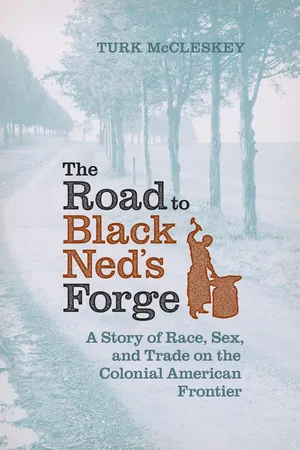
The Road to Black Ned's Forge
A Story of Race, Sex, and Trade on the Colonial American Frontier
- 336 pages
- English
- ePUB (mobile friendly)
- Available on iOS & Android
The Road to Black Ned's Forge
A Story of Race, Sex, and Trade on the Colonial American Frontier
About this book
In 1752 an enslaved Pennsylvania ironworker named Ned purchased his freedom and moved to Virginia on the upper James River. Taking the name Edward Tarr, he became the first free black landowner west of the Blue Ridge. Tarr established a blacksmith shop on the Great Wagon Road from Philadelphia to the Carolinas and helped found a Presbyterian congregation that exists to this day. Living with him was his white, Scottish wife, and in a twist that will surprise the modern reader, Tarr's neighbors accepted his interracial marriage. It was when a second white woman joined the household that some protested. Tarr's already dramatic story took a perilous turn when the predatory son of his last master, a Charleston merchant, abruptly entered his life in a fraudulent effort to reenslave him. His fate suddenly hinged on his neighbors, who were all that stood between Tarr and a return to the life of a slave.
This remarkable true story serves as a keyhole narrative, unlocking a new, more complex understanding of race relations on the American frontier. The vividly drawn portraits of Tarr and the women with whom he lived, along with a rich set of supporting characters in Pennsylvania, South Carolina, and Virginia, provide fascinating insight into the journey from slavery to freedom, as well as the challenges of establishing frontier societies. The story also sheds light on the colonial merchant class, Indian warfare in southwest Virginia, and slavery's advent west of the Blue Ridge. Contradicting the popular view of settlers in southern Virginia as poor, violent, and transient, this book--with its pathbreaking research and gripping narrative--radically rewrites the history of the colonial backcountry, revealing it to be made up largely of close-knit, rigorously governed communities.
Frequently asked questions
- Essential is ideal for learners and professionals who enjoy exploring a wide range of subjects. Access the Essential Library with 800,000+ trusted titles and best-sellers across business, personal growth, and the humanities. Includes unlimited reading time and Standard Read Aloud voice.
- Complete: Perfect for advanced learners and researchers needing full, unrestricted access. Unlock 1.4M+ books across hundreds of subjects, including academic and specialized titles. The Complete Plan also includes advanced features like Premium Read Aloud and Research Assistant.
Please note we cannot support devices running on iOS 13 and Android 7 or earlier. Learn more about using the app.
Information
Notes
ABBREVIATIONS
DB | Deed Book |
MB | Minute Book |
OB | Order Book |
VB | Vestry Book |
WB | Will Book |
EJC | H. R. McIlwaine et al., eds., Executive Journals of the Council of Colonial Virginia |
JCV | H. R. McIlwaine et al., eds., Journals of the Council of the State of Virginia |
JHB | H. R. McIlwaine et al., eds., Journals of the House of Burgesses of Virginia |
Alderman Library | Alderman Library, University of Virginia |
APS | American Philosophical Society |
Augusta CCC | Augusta County Clerk of Circuit Court |
Augusta DB | Augusta County Deed Book, microfilm, Library of Virginia |
Augusta OB | Augusta County Order Book, microfilm, Library of Virginia |
Augusta Parish VB | Augusta Parish Vestry Book, photocopy, University of Virginia |
Augusta WB | Augusta County Will Book, microfilm, Library of Virginia |
BHS | Virginia Baptist Historical Society |
BNA | British National Archives (formerly British Public Record Office) |
CCP | Court of Common Pleas, South Carolina Department of Archives and History |
Draper Mss. | Lyman Copeland Draper Manuscript Collection, Wisconsin Historical Society |
FHL | Friends Historical Library, Swarthmore College |
HMWV | History Museum of Western Virginia |
HSP | Historical Society of Pennsylvania |
LCHS | Lancaster County Historical Society |
Leyburn Library | James G. Leyburn Library, Washington and Lee University |
LOC | Library of Congress |
LOV | Library of Virginia |
PCA | Philadelphia City Archives |
Perkins Library | William R. Perkins Library, Duke University |
PHMC | Pennsylvania Historical and Museum Commission Archives |
PHS | Presbyterian Historical Society |
PRWA | Philadelphia Register of Wills Archive |
SCDAH | South Carolina Department of Archives and History |
Swem Library | Earl G. Swem Library, College of William and Mary |
UPS | Union Presbyterian Seminary |
VHS | Virginia Historical Society |
Walker Papers | Thomas Walker Papers, Library of Congress |
Winterthur | Winterthur Museum Library |
INTRODUCTION
1. THE YEOMAN
Table of contents
- Cover
- Half title
- Title
- Copyright
- Dedication
- Contents
- List of Illustrations
- Introduction: Opportunism and Mobility in Eastern North America, 1680–1780
- I. The Yeoman’s Dilemma
- II. The Safety Valve
- III. Individuals and Social Change
- Appendixes
- Acknowledgments
- Notes
- Bibliography
- Index